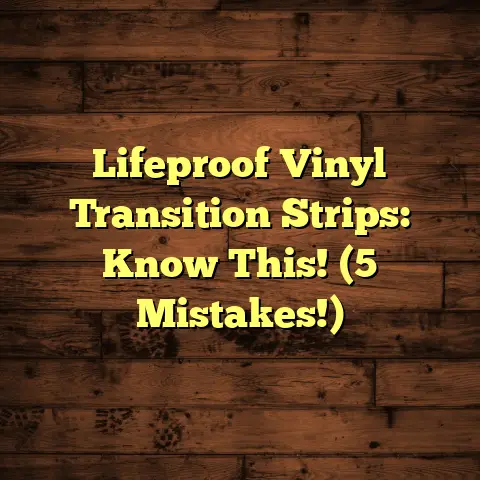Fix Squeaking Floor Joists? (2 Minute Solution!)
Is there anything more annoying than that one spot on your floor that screams every time you step on it?
It’s like living in a haunted house, except the ghost is just a miserable nail.
Squeaky floors aren’t just irritating. They can actually impact your home’s value and overall comfort.
Think about it: every potential buyer who walks through your house is going to notice that squeak.
And trust me, it sticks in their minds.
The good news? You don’t need to be a professional to fix it.
In fact, I’m going to share a solution that you can probably tackle in about two minutes.
Yes, you read that right. Two minutes to silence that annoying squeak and restore peace to your home.
Let’s dive in!
Section 1: Understanding the Cause of Squeaking Floor Joists
Before we grab our tools, let’s understand why your floor is squeaking in the first place.
Think of your floor as a layered system. You’ve got the finished floorboards (the part you walk on), then the subfloor (usually plywood or OSB), and finally, the joists.
Joists are the horizontal beams that support the entire floor structure.
They’re the backbone of your floor.
So, what causes that dreaded squeak? Here are the usual suspects:
-
Friction is the main culprit. When you walk across the floor, the floorboards rub against the joists or the subfloor. Over time, this friction can loosen the fasteners (nails or screws) and create that annoying squeak.
-
Loose nails or screws are a common issue. As wood dries and settles, nails can pop up or screws can loosen. This creates space for movement and, you guessed it, squeaking.
-
Wood expansion and contraction are inevitable. Temperature and humidity changes cause wood to expand and contract. This movement can put stress on the flooring and joists, leading to friction and squeaks. I’ve seen this a lot in older homes.
-
Moisture is a big problem. Excessive moisture can warp wood and loosen fasteners. I once worked on a house where a leaky pipe had caused extensive damage to the subfloor and joists. The squeaks were deafening!
-
Improper Installation: Sometimes, the squeak was there from the beginning. If the floor wasn’t installed correctly, or if low-quality materials were used, squeaks are almost guaranteed.
Don’t worry if this sounds complicated. It’s not!
The key takeaway is that squeaks are usually caused by movement and friction. Our goal is to eliminate that movement and reduce the friction.
Section 2: Tools and Materials Needed
Okay, let’s get practical. For this super-quick fix, you won’t need a truckload of tools.
Here’s what you’ll need:
-
Hammer or Nail Gun: A hammer works fine for small jobs. If you’re dealing with a larger area, a nail gun will save you a lot of time and effort. I personally prefer a nail gun because it’s faster and more precise.
-
Wood Screws (1 1/4″ to 1 5/8″): Screws provide a much stronger hold than nails. Choose screws that are long enough to penetrate the joist but not so long that they poke through the ceiling below. I recommend using drywall screws or wood screws.
-
Talcum Powder or Graphite: These are lubricating agents that can reduce friction between the floorboards and joists. Talcum powder is readily available and inexpensive. Graphite is a bit more effective but can be messier.
-
Flashlight: Essential for inspecting dark spaces under the floor or in the basement. You’d be surprised what you can find lurking under there!
-
Drill (Optional): If you’re using screws, a drill will make the job much easier. Pre-drilling pilot holes can also prevent the wood from splitting.
-
Safety Glasses: Always protect your eyes when working with tools. Trust me, you don’t want to get a nail or splinter in your eye.
That’s it! Pretty simple, right?
You probably have most of these items lying around your house already.
Section 3: Quick Fix for Squeaking Floor Joists
Alright, it’s time to silence that squeak! Follow these steps, and you’ll be walking on a quiet floor in no time.
Step 1: Identify the Source of the Squeak
This is the most crucial step. You need to pinpoint exactly where the squeak is coming from.
-
Walk around the area: Slowly walk across the floor, paying close attention to where the squeak is loudest. Try to narrow it down to a specific spot or a small area.
-
Apply pressure: Once you’ve identified the general area, try applying pressure to different spots. See if you can isolate the exact board or area that’s causing the noise.
-
Inspect the joists (if possible): If you have access to the joists from below (e.g., in a basement or crawl space), use a flashlight to inspect the area directly under the squeak. Look for loose nails, gaps between the joist and subfloor, or any signs of damage.
-
Listen carefully: Sometimes, the squeak can be deceptive. It might sound like it’s coming from one spot, but it’s actually originating from somewhere else. Pay attention to the direction of the sound and try to trace it back to its source.
I once spent an hour trying to find a squeak in a customer’s living room. It turned out the squeak was actually coming from a loose stair tread on the staircase next to the living room!
Step 2: Secure Loose Floorboards
Once you’ve found the source of the squeak, it’s time to secure the loose floorboards.
-
Using Nails: If the squeak is caused by a loose nail, simply hammer it back in. Use a nail set to drive the nail slightly below the surface of the wood. This will prevent it from sticking up and becoming a tripping hazard.
-
Using Screws: Screws are generally a better option than nails because they provide a stronger hold.
- Pre-drill a pilot hole: This is especially important if you’re working with hardwood. A pilot hole will prevent the wood from splitting. Use a drill bit that’s slightly smaller than the diameter of the screw.
- Drive the screw: Place the screw in the pilot hole and drive it in until it’s flush with the surface of the wood. Be careful not to overtighten the screw, as this can strip the threads and make the problem worse.
- Angle the screws: For maximum holding power, angle the screws slightly. This will help to pull the floorboard tightly against the joist.
-
Working from Below (if possible): If you have access to the joists from below, you can drive screws up through the joist and into the subfloor. This is often the most effective way to eliminate squeaks.
- Locate the squeak from above: Have someone walk on the floor above while you’re in the basement or crawl space. This will help you pinpoint the exact location of the squeak.
- Drive screws into the joist: Drive screws up through the joist and into the subfloor, right next to the existing nails. Use screws that are long enough to penetrate the subfloor securely.
Step 3: Apply Lubrication (if applicable)
If securing the floorboards doesn’t completely eliminate the squeak, try applying a lubricating agent.
-
Talcum Powder: This is a simple and inexpensive option.
- Apply the powder: Sprinkle talcum powder between the floorboards and the joists. You can use a small squeeze bottle or a powder duster to get the powder into the cracks.
- Work it in: Walk across the area to work the powder into the cracks. The powder will help to reduce friction between the floorboards and the joists.
-
Graphite: Graphite is a more effective lubricant than talcum powder, but it can be messier.
- Apply the graphite: Use a small brush or a squeeze bottle to apply the graphite between the floorboards and the joists.
- Be careful: Graphite can stain, so be careful not to get it on your clothes or furniture.
I’ve used both talcum powder and graphite with good results. Sometimes, it takes a few applications to completely eliminate the squeak.
Step 4: Test the Floor
After you’ve secured the floorboards and applied lubrication, it’s time to test your work.
-
Walk across the repaired area: Walk across the area where you fixed the squeak. Listen carefully to see if the squeak is gone.
-
Apply pressure: Apply pressure to different spots in the area. See if you can still make the floor squeak.
-
Repeat if necessary: If the squeak is still there, repeat the steps above. You may need to add more screws or apply more lubrication.
If you’ve followed these steps and the squeak is still there, it’s possible that the problem is more serious. In that case, you may need to consult a professional flooring contractor.
Section 4: Maintenance Tips to Prevent Future Squeaks
Now that you’ve silenced that annoying squeak, let’s talk about how to prevent future squeaks from developing.
-
Regularly inspect floorboards for loose screws or nails: Make it a habit to walk around your house and check for loose fasteners. Tighten any loose screws or hammer in any popped-up nails.
-
Control humidity levels in the home: As I mentioned earlier, wood expands and contracts with changes in humidity. Keeping the humidity level in your home consistent can help to prevent squeaks. I recommend using a humidifier in the winter and a dehumidifier in the summer. According to the EPA, ideal indoor humidity should be between 30-50%.
-
Ensure proper ventilation in crawl spaces and basements: Poor ventilation can lead to moisture buildup, which can damage your flooring and cause squeaks. Make sure your crawl space and basement are properly ventilated.
-
Avoid excessive weight on certain areas: Placing heavy furniture or appliances on areas that are prone to squeaking can exacerbate the problem. Try to distribute weight evenly across the floor.
-
Consider professional inspection: If you’re concerned about the overall condition of your flooring, consider hiring a professional flooring contractor to inspect it. They can identify potential problems and recommend preventative measures.
Preventative maintenance is always easier and less expensive than repairing damage after it’s already occurred. By following these tips, you can keep your floors quiet and comfortable for years to come.
Conclusion
So, there you have it! A simple, two-minute solution for fixing squeaking floor joists.
I’ve shown you how to identify the cause of the squeak, gather the necessary tools and materials, and implement a quick fix.
I’ve also shared some maintenance tips to help you prevent future squeaks.
Don’t let those annoying squeaks drive you crazy any longer. Take action today and restore peace and quiet to your home.
You might be surprised at how easy it is to fix the problem yourself. And who knows, you might even discover a hidden talent for home repair!
Now go grab your hammer (or nail gun) and get to work. Your ears (and your sanity) will thank you.





